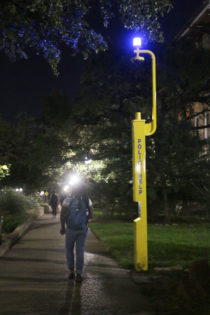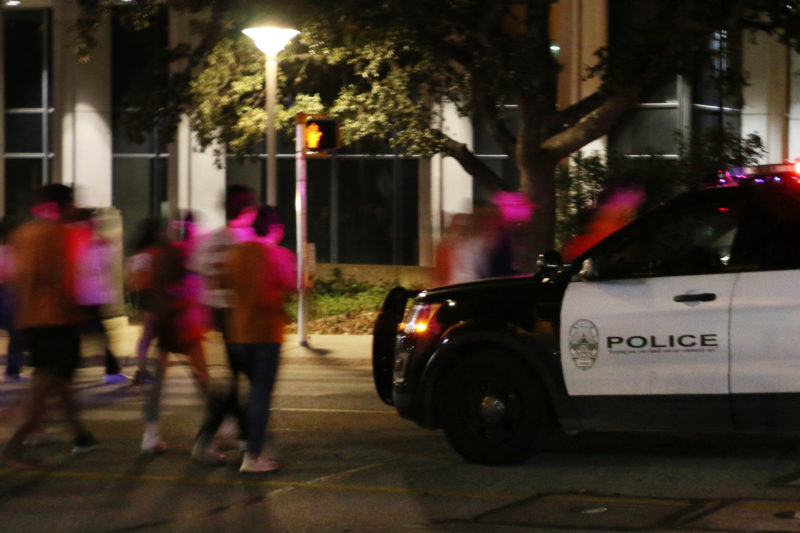UT Alerts Questioned After More Gun Violence
By Kevin Malcolm Jr.
Reporting Texas

University of Texas at Austin student, Christian Wedgwood, shows the Oct. 31, 2021 alert sent to students nearly 40 minutes after a shooting in West Campus. UT students have expressed frustration that alerts are not being sent out fast enough. Kevin Malcolm Jr./Reporting Texas
At 11:37 p.m. on Halloween, an officer with the University of Texas Police Department was listening to police scanners. He heard a man had been shot near the intersection of 22nd and Pearl streets in West Campus. Word quickly spread through campus via social media along with rumors and incorrect reports of multiple active shooters
It took UTPD close to 40 minutes to issue an alert to students through email about the shooting.
The alert read, in part, “A suspect vehicle is described as a silver older model SUV, possibly a Lexus occupied by three Hispanic males and one Hispanic female.”
UT student Kaya Epstein, who lives off campus, received dozens of concerned texts from friends after the shooting. She said that, even hours later, it was a struggle to find information about what actually happened.

Students at the University of Texas at Austin walk past a campus security office in November. Many have expressed concerns that delays in issuing safety alerts deprives them of information that could keep them safe. Kevin Malcolm Jr./Reporting Texas
“There’s really no other words to use than what the fuck? It was a vile ineptitude where they (UTPD) just disappeared,” Epstein said.
Joell McNew, board president of Safehorns, an organization committed to campus safety, was disappointed with how UTPD informed students.
“Without a follow-up, things were not clear, and students spread the information with no official message from the university,” McNew said.
The Halloween incident reminded McNew of the stabbing death of UT student Harrison Brown in 2017, she said.
In the Brown case, it took UTPD about 30 minutes to alert students after a UT student stabbed Brown and several other students near Gregory Gym. In that half-hour, rumors of an active threat on campus proliferated.
David Carter, UT police chief at the time, said the suspect was apprehended, and “the situation was resolved quickly.” Carter went on to say, “The university tries to put out information as quickly as possible so people will know. But there’s a difference between putting out information to help people understand and alleviate their fears and then also putting out an emergency notification.”

A University of Texas at Austin student walks past a campus police call box in November. Kevin Malcolm Jr./Reporting Texas
UT has a policy to send alerts via email and/or text when a crime has been reported and there is an ongoing threat to campus. Text alerts are sent to all students and faculty and staff who chose to receive them “to communicate a credible, immediate, ongoing threat to campus,” according to the UTPD website. Email notifications are sent to everyone in the UT community about crimes or incidents happening on or near campus.
This is part of a wider nationwide practice required by the 1990 Clery Act. The act requires universities to report crime on campus.
Some students at UT think there is considerable confusion when alerts should be sent.
All 911 calls in West Campus go directly to the Austin Police Department. APD determines whether to notify UTPD of incidents happening off campus that could possibly endanger university students. Acting chief for UTPD Don Verett reached out the day after Halloween to Austin Police Chief Joseph Chacon to discuss what went wrong on Halloween night.

University of Texas at Austin basketball fans cross the street with help from Austin police on Dec. 4, 2021. Under the current alert system, Austin police determine what information is sent to UT police when incidents happen off campus. The department has committed to sending more information to campus police, according to UT Police Chief Don Verett. Kevin Malcolm Jr./Reporting Texas
“The Austin Police Department is committed to sending us more information moving forward, specifically, regarding incidents in progress in our high-density student housing areas. We will share that information with our community members so that they may make appropriate safety decisions,” Verett said.
One day after the Halloween shooting, both Austin and the UT police departments responded to terroristic threats made at a 7-Eleven convenience store near campus. The suspect led police on a car chase through West Campus for about 45 minutes until he crashed into a cement truck and was caught. For the second night in a row, students were alerted to the incident after it was over.
“The incident was potentially dangerous. However, it concluded very quickly before an alert could be issued,” Verrett said. He added he was confident in the current system in place to notify students.
On Nov. 3 and 4, the university sent seven text alerts to students concerning incidents, including reports of shots fired, aggravated assault and robbery as they happened rather than after the issue had been resolved.
After the alerts on Nov. 4, students did not receive additional text alerts from the university for at least two weeks. Despite complaints from students who say they would like to be notified of potentially dangerous incidents more quickly, Verrett told Reporting Texas via email he has no plans to change the student alert system.